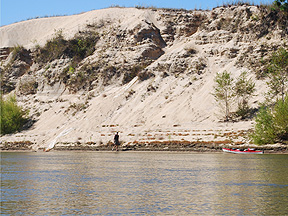
At Apalachicola Riverkeeper, we see four fundamental threats to the health, ecological productivity, and biological diversity of the Apalachicola River and Bay, and to the lives and livelihoods of people who depend on these resources. Each of these threats were identified by founding members in 1994. A fifth, dire threat includes the impacts of climate change.
- Loss of life-sustaining freshwater
- Loss of floodplain and wetland habitat
- Point-Source and Nonpoint-Source Pollution, and
- Unrestrained growth and development.
Loss of life-sustaining freshwater
The River’s flow level is significantly reduced by extreme and persistent drought conditions. Persistent low flows hurt the plants, animals, and people who depend on the river, its floodplain, and bay. The management by the Corps of Engineers of the River’s major upstream tributaries — the Chattahoochee and Flint Rivers in Georgia – make the low-flow periods in the Apalachicola more frequent, more severe, and longer lasting than would be caused by natural events alone. To restore the health of the River and Bay, we must change the way the Corps manages these Rivers. These problems have existed for 30 years, but changed from chronic to crisis in 2012, when the seafood productivity of the Bay collapsed.
Apalachicola oysters, which are dependent on high flows of fresh water to reduce the salinity of the Bay, and which die off during the lowest-flow years, have dramatically reduced in number and size. Oyster harvesters and local seafood workers can no longer depend on the Bay for their living. Shrimp and crab harvests are also smaller. On September 6, 2012, Florida Governor Rick Scott sent an emergency request for relief to the federal government declaring a “Commercial Fishing Resource Disaster” in the Apalachicola Bay. According to Scott, “The State of Florida has experienced an unprecedented decline in the abundance of oysters within our coastal estuaries, a direct consequence of which has been a significant loss of income to commercial oyster fishermen, oyster processors and rural coastal communities.” These problems are made worse by the poor local economic conditions, which push people to the Bay for both food and income.
Loss of floodplain and wetland habitat

The floodplain shrinks and dries out as the result of decreased river flow, which causes plants and animals to suffer and decline. For example, one long‑term study estimated that we’ve lost over 1 million Tupelo trees in the floodplain, with an additional 3 million trees lost in nearby areas. This creates a ripple effect of loss of other species and industries, in this case tupelo honey production. Other species with natural, human, or economic importance that have been affected by the too-dry, low-flow conditions include crawfish, catfish, striped bass, bream, and the endangered gulf sturgeon. Although low flow is the most significant cause of habitat loss, there are other problems: many of the creeks and sloughs that carry water out of the River and into the swamps are now blocked by “sand plugs” where they meet the River. These plugs are the consequence of 50 years of channel‑dredging by the Corps of Engineers. Although the dredging was halted in the early 2000’s, the massive accumulations of dredged‑up sand along the riverbanks continue to drift and shift. Floodwaters carry sufficient quantities of sand into the sidewaters to eventually block these waterways, and swamp‑dwelling organisms are denied life‑giving water and nutrients.
Watch Apalachicola River & Bay: A Connected Ecosystem here.
Point and Nonpoint Source Pollution
Point-source pollution comes from a single location, like a discharge pipe from a factory, or a broken oil well. We may never know the full impact on the natural world of the BP oil spill in 2010, and the chemicals that were used to ‘disperse’ the oil, but it surely didn’t make anything better. Similarly, in addition to the big spills that attract attention, there are many chronic spills into Gulf waters that collectively have a huge negative impact on the ecosystem. One spill in particular known as the “Taylor Well Spill” has been pouring oil into the Gulf from multiple wells ever since 2004! Apalachicola Riverkeeper was a lead plaintiff in a major lawsuit aimed at stopping this spill, and will not rest until it ends. We stand ready to respond to other such threats to the quality of water in our River and Bay.
Nonpoint-source pollution comes from the flow of stormwater and groundwater over wide areas. This pollution includes herbicides and pesticides (from farms, golf courses, tree farms, and residential lawns), petroleum products and heavy metals (from roads and highways), nitrate pollution that flows from livestock operations, and sediment that is released by forestry operations. For much of its 107 mile course the Apalachicola River is well-protected from many of these threats, thanks a wide floodplain without significant development nearby. That cannot be said for the major tributaries in Georgia (Chattahoochee and Flint Rivers) whose paths take them close to major development in north Georgia and major agriculture in south Georgia. Most major point-sources of pollution have been regulated by the federal Clean Water Act since 1972. In the Apalachicola River, as in most rivers, nonpoint-source pollution is the greatest threat, and the greatest challenge to control.
Unrestrained growth and development
The freshwater flow of the Apalachicola River begins many miles away high above Atlanta in the Appalachian Mountains. The unbridled growth and development of urban areas puts tremendous demands on water resources throughout the ACF basin. Upstream development also leads to increases in both point-source pollution (from industries and wastewater treatment plants) and nonpoint-source pollution (from urban development). Reservoirs established upstream of the Apalachicola River to meet the needs of communities there have caused severe limitations on freshwater flows coming into the River and Bay. Even if we alter the way the Corps of Engineers manages the reservoirs, the growth of the upstream populations will continue to increase the demand for water. Without reasonable restraints on water use and pollution upstream, the health of the River will continue to be compromised.
